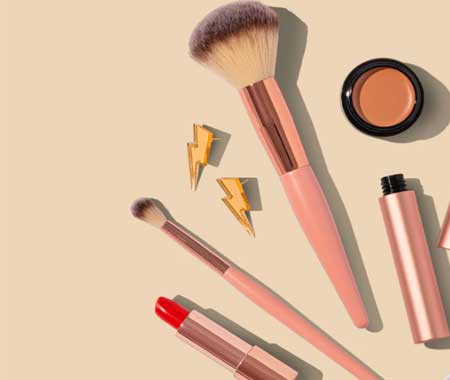Which are the non-vegan ingredients in the cosmetics and beauty products you use? Do you think it is just milk and honey? Animal-derived ingredients such as pee, skin oil, or boiled bones, vomit, and other spooky stuff are there. Not cool. All we need is to be aware of them, read the labels, and choose wisely.
But let’s see first what is vegan beauty and what is the difference between vegan cosmetics and cruelty-free cosmetics.
Vegan beauty means that the cosmetic products do not contain ingredients of animal origin while cruelty-free cosmetics mean that the products were not tested on animals.
Why is it important to be aware of this differentiation?
Cosmetics can be vegan (no ingredients of animal origin) but they can still be tested on animals or contain ingredients tested on animals. On the other side, cruelty-free cosmetics are not tested on animals but they may still contain ingredients of animal origin. If the consumer wants to ensure that no animal has been hurt, he/she must check both vegan and cruelty-free signs on the packaging.
On the label, we will usually see one or the other or both or neither of the two. A vegan sign on a cream does not mean no animal suffering occurred to produce it. On the other hand, a product with the label “cruelty-free” or “not tested on animals” may still contain ingredients of animal origin. Therefore, we should aim to buy only products that are both vegan and cruelty-free. A small choice makes a big difference!
Ingredients that are non-vegan in your cosmetics and where they come from
Carmine
Do you think you have never eaten insects? You are wrong. Carmine is everywhere, from sweets, soft drinks, donuts, lipsticks, and various other cosmetics. It comes from crushed bugs (known as cochineal) that live in Latin America, mainly Peru. The cochineal insects live on cacti and the farmers collect them, dry, and smash their bodies. The carminic acid contained in these bugs represents a quarter of the insect’s weight. The product is very stable, yet there are plenty of natural plant-based alternatives that do not imply the suffering of these living creatures. On the label, it may also have one of the following names: cochineal or cochineal extract, natural red 4, crimson lake, CI 75470, or E 120.
Lanolin
The word lanolin comes from the Latin “Lana” meaning wool and “lin” meaning oil. Other names for the same products are wool grease, wool wax, or wool yolk. This wax-like substance comes from the sheep wool. If you skip a shower, doesn’t your skin become a bit oily? What if you skipped shower forever? Imagine putting on your face that oily wax produced by the sheep… You will find lanolin in facial cosmetics and lip balms, medical creams, shoe polish, lubricants, etc. Lanolin’s extraction comes from the sheep wool, after washing it in hot water. The wool industry is a hell of pain and suffering. Let’s be mindful and say no.
Elastin
Elastin is a key protein produced by the human body and it is responsible for the elasticity of arteries, lungs, tendons, skin, and ligaments. This ingredient used in cosmetics is produced from animal connective tissue (usually cow). The elastin that comes from fish skin is also called Marine Collagen. The damage caused to skin elastin is one of the hardest to heal and prevention is key. Even if researches have proven little effect or no effect at all from applying elastin on the skin, there are still plenty of companies that use it as an ingredient for skincare products.
Collagen
Collagen is another important protein and our body produces it naturally. It is not a secret that the collagen molecule is bigger enough not to be able to penetrate the skin. Yet, it is present in anti-aging creams (more for its placebo effect obviously). There are plenty of products that contain collagen nowadays for internal use (think of how the stomach acid breaks down everything that goes in). Collagen in cosmetics comes from animal tissue. Easy to avoid! Instead of collagen, try a healthy diet (beans are a great idea as they also contain copper which is a must for collagen, fruits, and vegetables for vitamin C and other minerals and nutrients).
Gelatin
Just like collagen, gelatin comes from boiling animal carcasses, bones, ligaments, skin, tendons. You will find it in food, cosmetics, photographic films, pills coating, and even in wine fining. (Source)
Allantoin
Allantoin, also labeled as urea or carbamide, is a common ingredient in cosmetics. You will find it in all sorts of skincare creams and lotions, shampoos, sun-care products, and even toothpaste and other oral hygiene products. It comes from the uric acid of an animal, mainly cows and in other words, it refers to animal pee. Synthetic allantoin or from plants is a good alternative. Therefore, it is advisable to check the labeling and choose wisely. Even if allantoin has soothing, moisturizing, and anti-oxidant effects on the skin, it can also create irritation to sensitive skin.
Estrogen or estradiol
Found in perfumes and creams, it comes from the urine of the pregnant horses.
Squalene
Squalene comes from the livers of sharks. Eye make-up products and lipsticks have plenty of it. Not cool.
Ambergris
Whale vomit. Yeah! And it might be there in your perfume!
Other non-vegan ingredients, derived from the animals: honey and beeswax, keratin, milk, omega-3, fish eggs etc.
A first step would be to avoid the above non-vegan ingredients in cosmetics. They too, just as the animal testing, imply pain and suffering. The animals are not ours to use and there are so many alternatives. Animal ingredients in cosmetics are not superior to plant-based ones. The future of the beauty industry is vegan and free of animal testing. More and more companies align to the no-harm philosophy. We can and we will make this world a better place to live in.
Here on veganolio, we only list products that are both vegan and cruelty-free.

